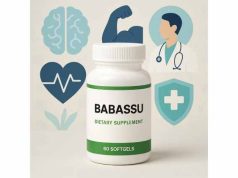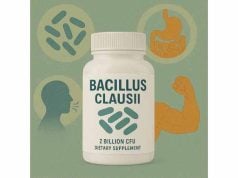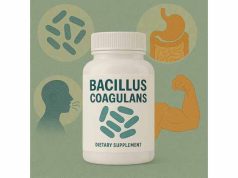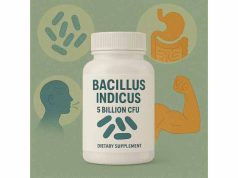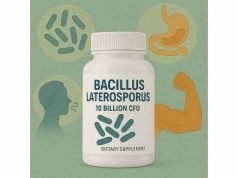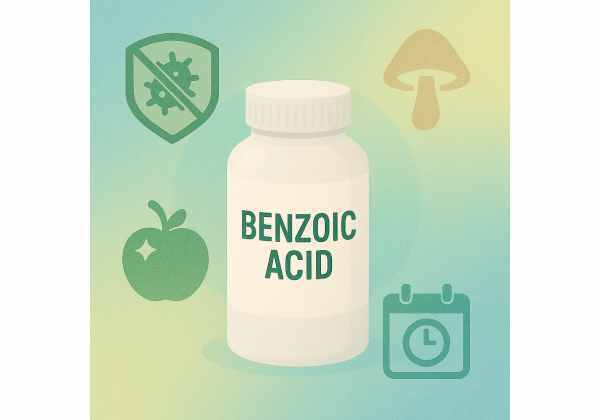
Benzoic acid is a naturally occurring compound found in many fruits, berries, and spices, widely recognized for its preservative qualities and historical medicinal uses. While best known as a food additive and a component in cosmetics, benzoic acid’s unique chemical structure gives it powerful antifungal, antibacterial, and anti-inflammatory properties. In recent years, interest has grown in its supplemental and therapeutic applications—from supporting skin health to maintaining urinary tract wellness. However, understanding its appropriate dosage, practical uses, and potential side effects is vital for safe and effective use. This comprehensive guide explores everything you need to know about benzoic acid, including evidence-based benefits and best practices for daily wellness.
Key Takeaways
- Natural preservative: Benzoic acid extends shelf life by inhibiting the growth of bacteria, yeast, and fungi in food and cosmetics.
- Supports skin health: Used in creams and ointments for its soothing, anti-irritant, and antimicrobial effects on rashes, fungal infections, and acne.
- Urinary tract wellness: May help maintain urinary tract health by reducing bacterial growth when used in specific supplement blends.
- Generally recognized as safe (GRAS): Benzoic acid is considered safe at approved concentrations, but excessive intake or misuse can cause side effects.
- Widely used in foods, drinks, and personal care: Most exposure comes from diet and topical products rather than supplements.
Table of Contents
- Benzoic Acid Overview: History and Its Role in Modern Wellness
- Mechanisms: How Benzoic Acid Works in the Body and in Products
- Core Benefits and Uses of Benzoic Acid in Health and Everyday Life
- Benzoic Acid Safety Guidelines, Tolerability, and Possible Side Effects
- Benzoic Acid Dosage Recommendations, Application Methods, and Usage Tips
- Benzoic Acid FAQ: Answers to Common Questions and Concerns
Benzoic Acid Overview: History and Its Role in Modern Wellness
Benzoic acid is a simple aromatic carboxylic acid first discovered in the 16th century in gum benzoin, a resin from certain trees. Its name comes from this botanical source, though the compound itself is found naturally in a variety of fruits (notably cranberries, prunes, and plums), certain spices, and even some dairy products. Today, benzoic acid is produced synthetically for use in food, cosmetics, and pharmaceuticals due to its effective preservation and health-supporting properties.
A Brief History
- Ancient use: Before the rise of refrigeration, benzoic acid-rich plant extracts and resins were prized for their ability to preserve foods and heal wounds.
- 19th century: Scientists isolated benzoic acid and began to understand its chemical structure and medicinal benefits, particularly as a mild antiseptic.
- Modern applications: Today, benzoic acid is a cornerstone of the food and cosmetics industries. It is listed as “Generally Recognized as Safe” (GRAS) by food safety authorities, allowing its widespread use as a preservative.
What Is Benzoic Acid?
Chemically, benzoic acid (C7H6O2) is a colorless, crystalline solid with a slightly sweet, pungent aroma. Its molecular structure allows it to disrupt the cell membranes of microbes, which underlies its ability to prevent spoilage and infection.
Natural Sources and Occurrence
- Fruits and vegetables: Cranberries, plums, prunes, ripe berries, and apples naturally contain small amounts of benzoic acid and its derivatives.
- Herbs and spices: Cinnamon, cloves, and certain teas also provide natural benzoates.
- Fermented foods: Some benzoic acid forms during fermentation, adding to the preservative power of items like soy sauce and pickles.
How Do We Use Benzoic Acid?
- Food preservation: Most commonly seen on ingredient labels as E210 (benzoic acid) or E211 (sodium benzoate), it prevents the growth of spoilage organisms in acidic foods and beverages—such as sodas, fruit juices, salad dressings, and jams.
- Personal care: It is a mainstay in creams, ointments, toothpastes, and shampoos for its antimicrobial and skin-soothing effects.
- Supplements and medicine: Used in some urinary tract health blends, antifungal treatments, and cough syrups.
Why Is Benzoic Acid Important in Wellness?
- Reduces spoilage: Enables longer shelf life without refrigeration, improving food safety and access.
- Supports skin and urinary health: Its mild antimicrobial action can help manage minor infections and soothe irritation.
- Minimizes chemical exposure: As a naturally derived preservative, benzoic acid offers a safer alternative to harsh synthetic chemicals.
Is Benzoic Acid a “Supplement”?
While benzoic acid is primarily encountered as a food additive or topical agent, it appears in some dietary supplements (often paired with compounds like hippuric acid or cranberry extract for urinary tract health). Always check labels and use only products from reputable sources.
Summary
Benzoic acid has evolved from an ancient plant-based preservative to a modern health and wellness staple, valued for its safety, versatility, and gentle effectiveness when used properly.
Mechanisms: How Benzoic Acid Works in the Body and in Products
Understanding benzoic acid’s mechanisms helps explain why it’s such an effective preservative and gentle antimicrobial agent. Its unique chemistry enables both broad-spectrum protection in food and targeted health benefits when used topically or in supplements.
1. Preservative Action in Food and Cosmetics
Benzoic acid is most effective in acidic environments (pH below 4.5), which is why it’s added to sodas, fruit juices, pickles, and salad dressings. Here’s how it works:
- Cell membrane disruption: Benzoic acid penetrates the cell walls of bacteria, yeast, and molds, destabilizing their membranes and inhibiting vital functions.
- Enzyme inhibition: It interferes with microbial enzyme systems, halting their growth and preventing spoilage or infection.
- Acidic synergy: Its preservative power is amplified in the presence of other acids like citric acid or ascorbic acid (vitamin C), allowing lower concentrations to be effective.
2. Topical Effects: Skin and Mucous Membranes
Applied to the skin or mucous membranes, benzoic acid acts as a mild antimicrobial and anti-inflammatory agent:
- Inhibits fungi and bacteria: Used in ointments for athlete’s foot, ringworm, and minor wounds.
- Reduces irritation: Calms redness and itch in eczema or dermatitis due to its soothing effects on inflamed tissue.
- Aids wound healing: By preventing secondary infection, it supports the natural repair process.
3. Supplement and Internal Use
When taken in supplement form or as part of a urinary tract health product, benzoic acid:
- Metabolizes to hippuric acid: In the liver, benzoic acid combines with glycine to form hippuric acid, which is then excreted in urine. This helps “cleanse” the urinary tract by increasing antimicrobial activity and acidifying urine, making it less hospitable to infection-causing bacteria.
- Antioxidant properties: Some evidence suggests that benzoic acid and its derivatives may help scavenge free radicals, though this is a minor pathway compared to its preservative effects.
4. Natural Metabolism and Elimination
- Safe breakdown: The body efficiently processes and eliminates benzoic acid, primarily via the urine as hippuric acid. Only excessive or chronic exposure overwhelms this system, potentially leading to side effects.
5. Environmental and Industrial Uses
- Beyond health: Benzoic acid is used in plastics, dyes, and even as a corrosion inhibitor. However, only food- or pharmaceutical-grade benzoic acid is safe for human use.
Is Benzoic Acid Safe for Everyone?
For most people, the levels of benzoic acid encountered in food, cosmetics, and supplements are well within the body’s capacity to metabolize and excrete safely. Those with rare metabolic disorders (like glycine deficiency) may need to avoid it.
Summary of Mechanisms
- Disrupts microbes at the cellular level
- Preserves foods and products by halting spoilage
- Supports urinary and skin health when used appropriately
- Is rapidly processed and excreted by healthy bodies
Understanding these mechanisms provides the foundation for smart, safe use in daily life and wellness routines.
Core Benefits and Uses of Benzoic Acid in Health and Everyday Life
Benzoic acid’s diverse uses go far beyond simple food preservation. Its ability to gently but effectively control microbes, reduce irritation, and support the body’s natural defenses has made it an ingredient of choice for health-conscious consumers, food manufacturers, and clinicians alike.
1. Food Safety and Preservation
The primary benefit of benzoic acid is its potent preservation ability:
- Extends shelf life: Inhibits bacteria, yeast, and mold, keeping food and drinks fresh for longer.
- Reduces food waste: Allows products like jams, pickles, sauces, and sodas to stay safe without artificial preservatives.
- Protects against foodborne illness: By reducing spoilage organisms, benzoic acid indirectly lowers the risk of food poisoning.
2. Support for Skin Health and Healing
Benzoic acid is found in many over-the-counter skin creams and ointments due to its soothing and antimicrobial qualities:
- Athlete’s foot and fungal infections: Commonly paired with salicylic acid in topical products to treat fungal and bacterial skin conditions.
- Eczema and irritation: Reduces itch and inflammation, speeds healing of minor wounds and rashes.
- Acne-prone skin: Sometimes added to acne treatments for its gentle antibacterial action and ability to reduce oiliness.
3. Urinary Tract Wellness
Certain supplements and traditional herbal blends include benzoic acid to:
- Support urinary tract health: By increasing urinary acidity and antimicrobial activity, it helps create an environment hostile to harmful bacteria.
- Complement cranberry extract: The natural synergy of benzoic acid and other organic acids may enhance the effectiveness of urinary tract supplements, particularly for recurrent UTIs.
4. Potential for Antioxidant and Anti-inflammatory Benefits
- Free radical scavenging: While a minor effect, benzoic acid may provide some antioxidant benefits, helping to neutralize unstable molecules that can damage cells.
- Calms minor inflammation: Topical and, to a lesser extent, oral forms may provide soothing relief for redness, swelling, and minor discomfort.
5. Practical Home and Lifestyle Uses
- Oral care: Occasionally found in mouthwashes and toothpastes to control bacteria and maintain oral hygiene.
- Preserving natural cosmetics: A common preservative in shampoos, lotions, and deodorants for those seeking paraben-free formulas.
6. Emerging and Research-Based Uses
- Potential antifungal agent: Research is ongoing into the use of benzoic acid for nail fungus and other stubborn fungal infections.
- Synergy with other ingredients: Benzoic acid may enhance the effectiveness of other antimicrobial agents when combined in blends.
Who Benefits Most from Benzoic Acid?
- Health-conscious consumers looking for safer preservatives
- Individuals with minor skin irritations, rashes, or athlete’s foot
- Those prone to urinary tract infections seeking natural supplement support
- Anyone using natural personal care or food products requiring gentle preservation
Important Considerations
- Benzoic acid is not a cure for serious infections or diseases. For persistent symptoms, medical advice is essential.
- Use only within recommended doses; excessive intake, especially in children, can cause side effects.
Summary
Benzoic acid’s broad-spectrum benefits make it a valuable part of everyday wellness—protecting food, soothing skin, and supporting urinary health in safe, practical ways.
Benzoic Acid Safety Guidelines, Tolerability, and Possible Side Effects
Benzoic acid is classified as “Generally Recognized as Safe” (GRAS) by food safety authorities when used at approved levels. For most people, the amounts found in foods, beverages, and topical products cause no harm. However, like all substances, benzoic acid is not risk-free. Understanding its safety profile, who may be sensitive, and how to avoid overexposure ensures that you can benefit from its advantages without unnecessary risk.
General Safety and Regulatory Limits
- Food safety regulations: The FDA and EFSA strictly limit benzoic acid concentrations in foods, usually to no more than 0.1% by weight. These limits are well below levels known to cause adverse effects.
- Cosmetic products: Topical formulas use concentrations typically ranging from 0.2% to 2%, considered safe for adult skin.
- Supplements: When included in urinary health supplements, dosages are carefully calibrated and often paired with other natural acids or herbal extracts.
Tolerability in the General Population
Most people metabolize and excrete benzoic acid efficiently, especially when consumed at levels found naturally in foods or allowed in commercial products. The body converts benzoic acid into hippuric acid, which is quickly eliminated via urine.
Common Side Effects
While rare at typical exposure levels, side effects can occur with higher doses, chronic overuse, or individual sensitivity:
- Mild digestive discomfort: Some may experience nausea, abdominal pain, or mild diarrhea when ingesting large quantities.
- Skin reactions: Topical use can occasionally cause redness, stinging, or irritation—especially on broken or sensitive skin.
- Allergic responses: True allergies are uncommon but possible. Symptoms might include skin rash, itching, swelling, or rarely, respiratory distress after ingestion or skin contact.
Potential Risks with High Intake
- Hyperactivity in children: Some studies suggest a link between high intake of artificial food preservatives, including benzoic acid and sodium benzoate, and increased hyperactivity in children. Most children tolerate standard dietary amounts without issue, but highly processed foods should be consumed in moderation.
- Chronic exposure: Excessive, long-term intake (far above food safety limits) can stress the liver and kidneys, leading to metabolic disturbances.
- Benzene formation: Benzoic acid can react with ascorbic acid (vitamin C) in the presence of heat and light to form trace amounts of benzene, a known carcinogen. The levels found in foods and drinks are extremely low and monitored for safety.
Special Populations—Who Should Exercise Caution?
- Infants and young children: Their developing systems are more sensitive to all food additives. Always follow pediatric recommendations.
- People with metabolic disorders: Individuals with conditions like phenylketonuria (PKU), glycine deficiency, or severe liver/kidney disease should avoid supplemental benzoic acid due to altered metabolism.
- Pregnant or breastfeeding women: Occasional dietary intake is considered safe, but supplemental or medicinal use should only occur under medical supervision.
- Individuals with a history of allergies or asthma: More likely to experience hypersensitivity or adverse reactions.
Medication Interactions
Benzoic acid does not commonly interact with prescription medications. However, because it is metabolized in the liver, those taking drugs affecting liver function should consult a healthcare provider.
How to Avoid Side Effects
- Use within recommended guidelines: Always follow food, supplement, or topical product instructions.
- Watch for signs of sensitivity: If you notice rashes, breathing changes, or digestive upset after use, discontinue and consult a physician.
- Keep products out of reach of children: Accidental overconsumption is rare but possible, especially with concentrated forms or supplements.
Environmental and Long-Term Safety
- Eco-friendly profile: Benzoic acid breaks down easily in the environment and does not bioaccumulate in the food chain.
- Long-term use: No evidence suggests harm from lifelong dietary exposure at regulatory levels, but chronic overuse of supplements is discouraged.
Summary
For the vast majority, benzoic acid is safe, well-tolerated, and quickly eliminated from the body. Adverse effects are rare and typically linked to unusually high intake or individual hypersensitivity. Smart, moderate use ensures you benefit from its preservative and health properties without unnecessary risk.
Benzoic Acid Dosage Recommendations, Application Methods, and Usage Tips
Optimal use of benzoic acid requires understanding proper dosages, safe application methods, and practical tips for integration into daily wellness or self-care routines. Because most exposure comes from foods and topical products, it’s rare for individuals to require direct benzoic acid supplementation—except under specific health circumstances or professional advice.
1. Dosage Guidelines for Food and Supplement Use
- Food intake: The typical diet provides 5–20 mg of benzoic acid daily, mostly from fruits, vegetables, and processed foods.
- Supplements: Most urinary tract supplements contain 50–300 mg per serving, often combined with cranberry extract or hippuric acid. Always follow manufacturer instructions.
- Maximum safe daily intake: Regulatory agencies recommend not exceeding 5 mg per kg of body weight per day. For an adult weighing 70 kg (154 lbs), this equals about 350 mg/day from all sources.
2. Topical Application
- Ointments and creams: Follow the label; most products are formulated at concentrations proven safe for skin. For conditions like athlete’s foot, apply 1–2 times daily to clean, dry skin.
- Wound care: Only use products specifically labeled for broken skin. Benzoic acid ointments should never be applied to large or deep wounds unless directed by a healthcare professional.
3. Practical Usage Tips
- Storage: Store benzoic acid products in a cool, dry place, away from direct sunlight, and out of reach of children.
- Combine with other natural agents: When using for urinary or skin health, pairing with cranberry, D-mannose, or salicylic acid may enhance benefits.
- Dietary balance: Enjoy a varied diet rich in whole foods; focus on natural sources of benzoic acid (berries, cinnamon, plums) for added health benefits.
4. Special Considerations for Supplement Use
- Medical guidance: Only take benzoic acid supplements for urinary or skin health under the supervision of a qualified healthcare provider, especially if you have pre-existing conditions.
- Monitor for reactions: If you experience digestive discomfort, rashes, or other side effects, stop use and consult a physician.
- Children and sensitive groups: Avoid benzoic acid supplements in young children unless prescribed.
5. What to Avoid
- Overuse of processed foods: While benzoic acid helps preserve shelf life, excessive reliance on processed foods can increase overall additive intake. Choose fresh or minimally processed options when possible.
- Mixing with vitamin C in hot, bright environments: To minimize benzene risk, don’t store sodas or juices containing both benzoic acid and ascorbic acid in warm or sunny conditions.
6. Natural Ways to Harness Benzoic Acid Benefits
- Home preservation: Use naturally benzoic acid-rich ingredients (like cranberries or cinnamon) for jams and homemade preserves.
- DIY skincare: Some natural recipes use diluted benzoic acid as part of homemade balms for fungal or bacterial skin issues, but never exceed safe concentrations or apply to broken skin without professional guidance.
Summary
Moderation and awareness are key when using benzoic acid. Rely on reputable products, follow all dosage and safety instructions, and enjoy the protective and wellness benefits of this time-tested compound.
Benzoic Acid FAQ: Answers to Common Questions and Concerns
Is benzoic acid safe to eat every day?
Yes, benzoic acid is safe to consume daily at levels found in foods and drinks. Avoid exceeding regulatory limits or taking large supplemental doses without medical guidance.
Can benzoic acid help prevent urinary tract infections?
Benzoic acid may support urinary tract health by increasing urine acidity and antimicrobial activity, making it less hospitable for infection-causing bacteria. It’s often combined with cranberry in supplements for this reason.
What are common side effects of benzoic acid?
Mild digestive upset or skin irritation are the most common side effects, usually at high intake or in sensitive individuals. Allergic reactions are rare. Most people experience no issues at dietary or topical exposure levels.
Is benzoic acid bad for children or pregnant women?
At food-level exposures, benzoic acid is considered safe for children and pregnant women. Supplements or medicinal use should be approved by a healthcare provider.
Can benzoic acid trigger allergies or asthma?
Benzoic acid is rarely allergenic but can trigger hypersensitivity in some people, especially those with asthma or multiple allergies. Discontinue use if you experience symptoms.
How much benzoic acid is too much?
Regulatory agencies set safe limits—usually up to 5 mg per kg body weight daily. Exceeding these limits may cause side effects, particularly with chronic or high supplemental use.
Does benzoic acid interact with medications?
Benzoic acid has few known drug interactions. Those with liver or kidney disorders, or those taking medications affecting these organs, should consult a doctor before use.
Disclaimer:
This article is for informational and educational purposes only and does not constitute medical advice. Always consult your healthcare provider before starting any new supplement, especially if you are pregnant, breastfeeding, have a medical condition, or take prescription medications.
If you found this guide useful, please share it on Facebook, X (formerly Twitter), or your favorite social network. Follow us for more science-based wellness content—your support helps us keep providing quality health information!


